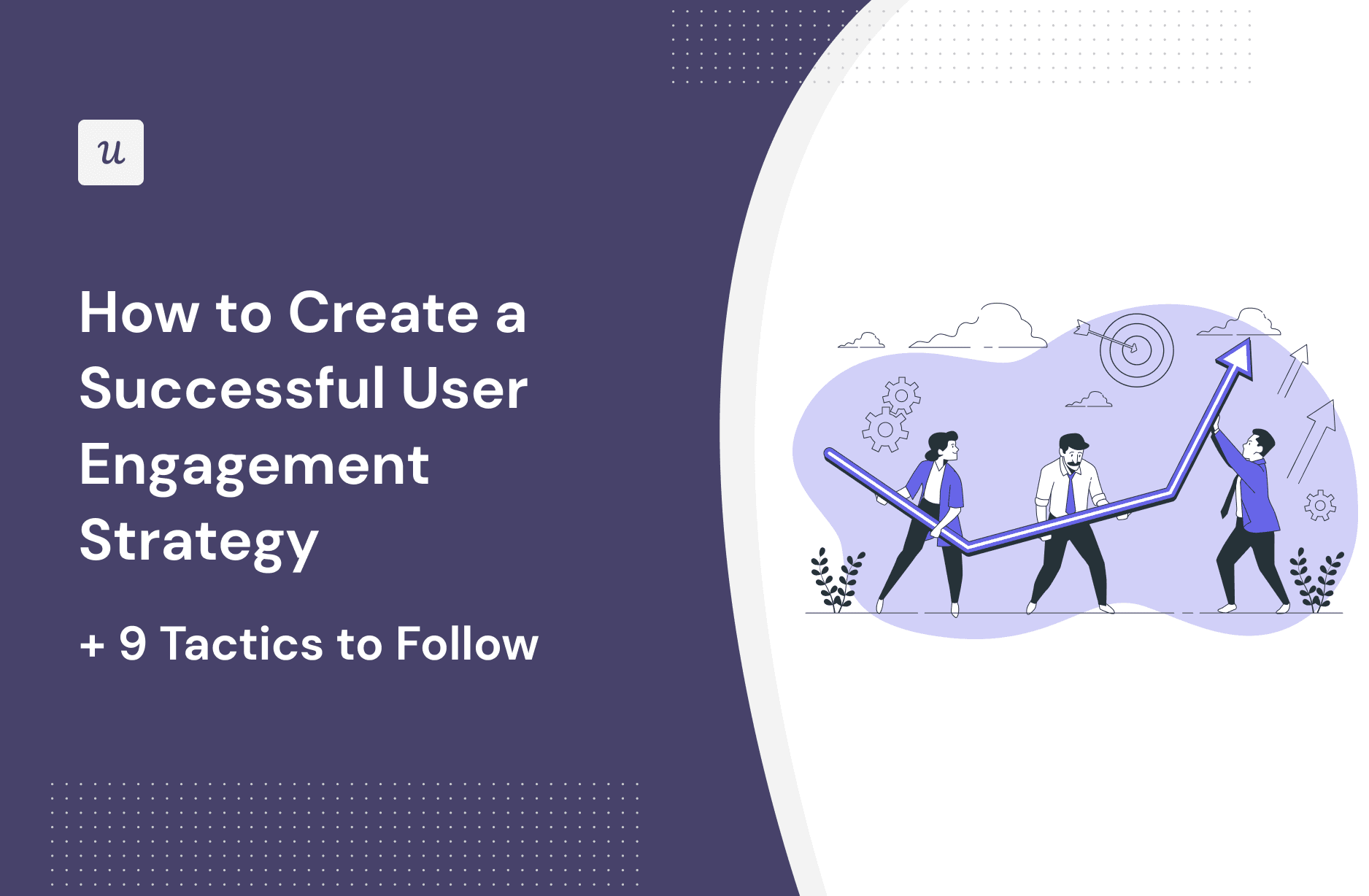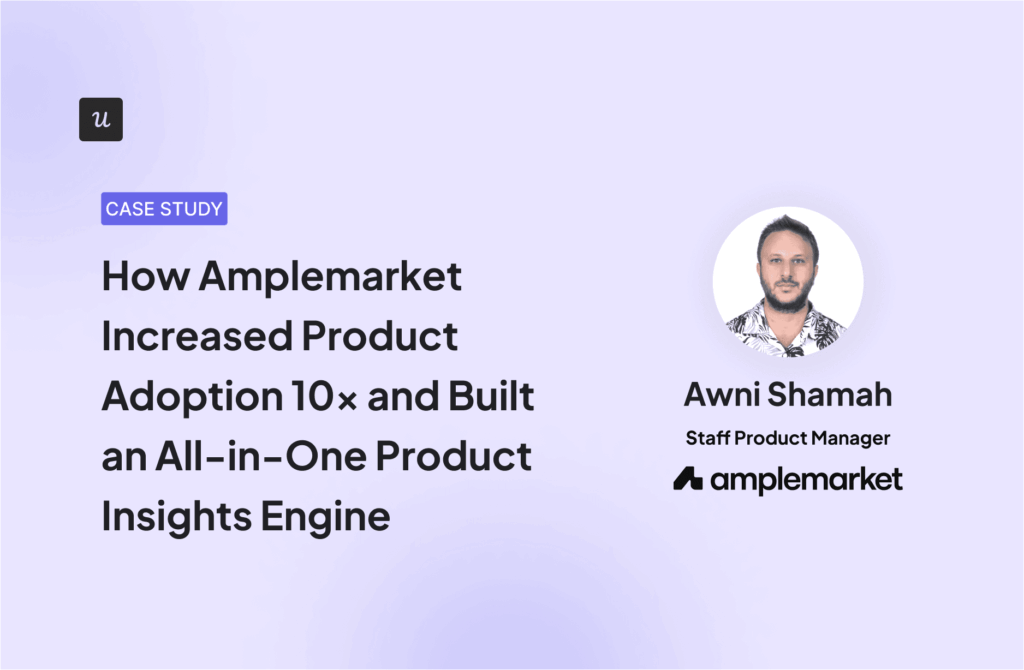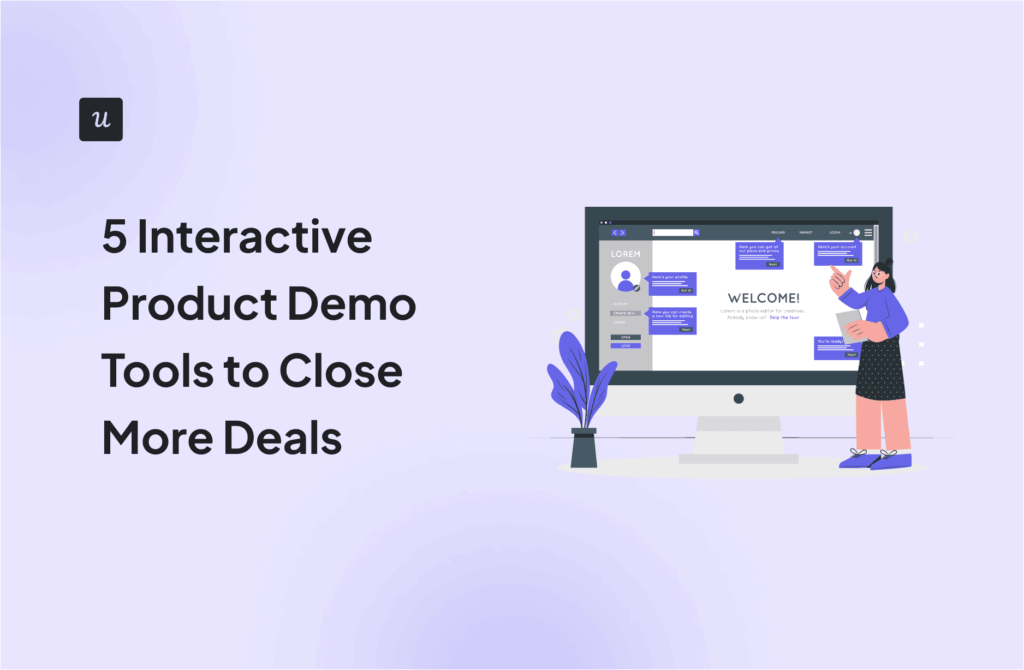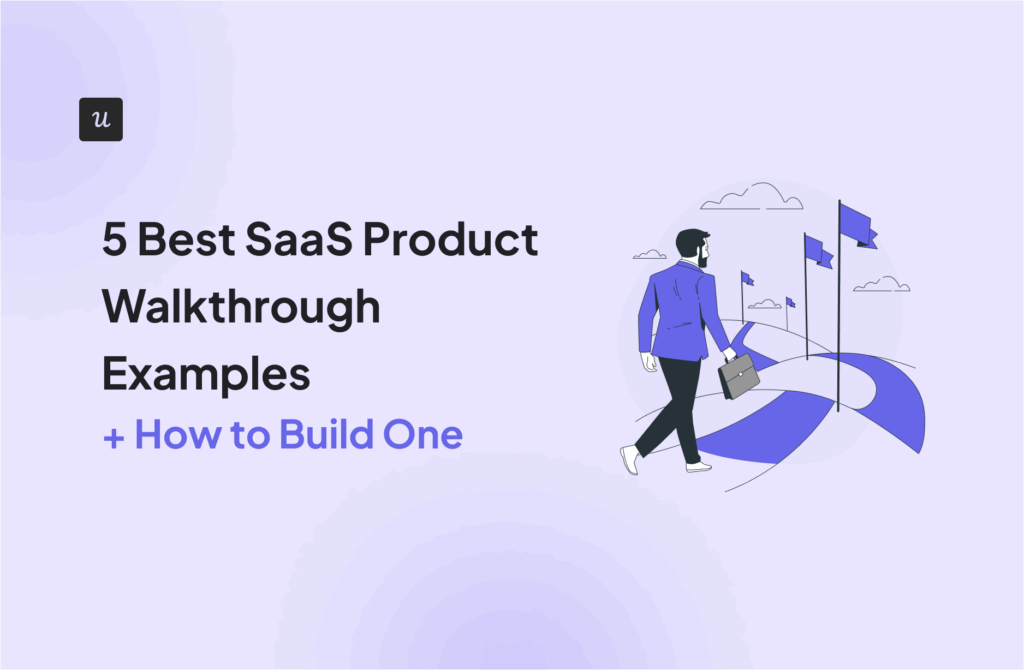
How to Create a Successful User Engagement Strategy + 9 Tactics to Follow
A product without a good user engagement strategy is like a rubbish boyfriend. No attention, support, trust, commitment, or respect. The only difference is that you don’t get casual encounters but invoices to pay and ill-timed upgrade pop-ups.
In this article, we show you how not to be that kind of boyfriend… I mean product.
We explain:
- What is a user engagement strategy
- Why it is important
- How to create it
- What tactics can you use to engage your users
We also look at examples of companies with excellent engagement strategies.
That’s quite a bit, so without further ado, let’s dive in!
Get The Insights!
The fastest way to learn about Product Growth, Management & Trends.
What is a customer engagement strategy?
A customer engagement strategy is a plan designed to keep users’ attention through meaningful interactions at all stages of their journey through the product.
By creating a positive customer experience and continuously adding value, the strategy fosters long-term relationships with customers.
Why is it important to implement a user engagement strategy?
A user engagement strategy is essential to retain your users.
Kind of makes sense: you need to keep users interested in the product. If you don’t, they will soon get bored, forget about you, and move on.
There’s much more to it than cheap thrills that keep users excited, though.
A robust customer engagement strategy;
- Supports and guides them
- Anticipates their needs and addresses their pain points
- Helps them realize the product value and achieve their goals
- Injects delight into the user experience
These are the things that turn customers into loyal brand advocates.
How to create an effective user engagement strategy?
Building a successful customer engagement strategy doesn’t need to be complicated. Our guide takes you through the process, step by step.
Conduct research on your existing customers
The first step in the process is customer research.
The goal here is to identify user needs and goals – as well as their pain points. This will help you prioritize your engagement efforts.
As a SaaS product manager, you have 4 main sources of customer data available:
- Feedback from customer-facing teams
- Feedback from in-app surveys
- Product analytics
- Interviews
For a complete view of your customer needs, use all of them.
Map out the customer journey and identity touchpoints at each stage
To engage your users effectively at all stages of the journey, you need to map it for all user personas.
Start by breaking down the journey into the main stages, like awareness or acquisition, and matching goals.
For each stage, the touchpoints are where user interactions take place. So at the awareness stage, this could be the ads that attract the users while at the acquisition – the sign-up form. Add corresponding user actions.
Finally, use your research insights to list the feelings and pain points that the user persona experiences when interacting with the product.

Implement effective customer engagement strategies at each touchpoint
Now that you know how users behave at different stages and what their experience is like, you can choose appropriate strategies to engage them.
We cover the strategies that you can use in detail in the next section.
For now, let me give you an example:
When a user is about to reach their usage limit, an effective way to engage them could be triggering contextually an upsell modal that prompts them to upgrade to a higher plan.
In this way, you allow them to continue using the product to advance their goals while benefiting from account expansion and higher customer lifetime value.
Track user engagement metrics at crucial stages
To know if your user engagement strategy is working, you need to track relevant metrics.
These include:
- Active Users – Daily, Weekly, Monthly (DAUs/WAUs/MAUs)
- Feature/product usage rate
- Feature/product adoption rate
- User retention and churn rate
The exact choice of metrics depends on your product and the customer pain points you’re trying to address. It’s good practice to add them all to a dashboard so that you have all relevant insights in one place.

Collect customer feedback to identify improvements
Collecting customer feedback is another way to assess the effectiveness of your strategy and identify opportunities to improve it.
As you are gathering insights on very specific aspects of user experience, it’s best to collect feedback contextually.
In practice, this means creating in-app surveys that are triggered when a user completes an action, like completing an onboarding flow or engaging with a feature. In this way, the experience is still fresh in their minds and their insights are potentially more valid.
Having said that, it’s still important to run general satisfaction surveys at regular intervals.

Iterate on your strategy to increase user engagement
How much is the user feedback worth depends on what you do with it. If you don’t act on it, you might as well not bother.
But we don’t ignore user feedback, do we? Of course, not.
We analyze it, identify solutions, implement them, and monitor their impact. And repeat the process again and again because there’s always something to improve.
9 customer engagement strategies to implement
The above steps provide a framework for an effective user engagement strategy. Let’s have a look at specific techniques for engaging customers at different stages of the journey.
1. Create a personalized customer experience from the get-go
Nobody likes getting generic messages that could have been meant for everyone else. Apart from feeling fake and unnatural, they’re usually not very helpful.
The same applies to user engagement.
By personalizing the user experience, you not only make the users feel special but address their unique needs as well. This means not only addressing them by their first name but also;
- Tailoring the onboarding process to their use cases
- Customizing the product dashboard with templates and shortcuts relevant to the users
- Driving engagement with relevant features
- Localizing microcopy, surveys, and support resources
- Triggering customized upsell and cross-sell messages
Of course, in SaaS products, you can’t customize the product for each individual user, but you definitely should for main user segments.

2. Drive activation with an onboarding checklist
There’s a good reason why many time management and organization systems are built around checklists: they’re very effective at driving action. They give you focus, and the more items you tick off, the more motivated you feel to carry on until all tasks are done.
That’s why they’re also super effective for user activation.
Simply give your users a few tasks that they need to complete to start using the product and experience its value, like inviting a teammate to a messaging platform or adding an account to a social media manager.
Just make sure the list isn’t too long and focuses on key processes. Add a progress bar to set expectations and reinforce the drive to finish.

3. Announce relevant features to keep users engaged
While the checklist focuses on introducing the main features, it’s best to introduce the more advanced ones gradually, when the users are competent enough to handle them. This makes the experience less overwhelming.
Contextual in-app messages are great for that. They get triggered when a user is in a place where they could benefit from a particular functionality. For example, you could trigger a tooltip prompting users to use a scheduling feature in a messaging app.
In-app messages are also great for announcing the shiny new features that you’re constantly adding to your product to better serve your users and leave your competitors in the dust.

4. Reward engaged users to make them loyal customers
Rewarding users for ongoing engagement and loyalty is a surefire way to hook them.
For example, you could give them access to a premium feature or increase their usage limits.
This strategy works particularly when the rewards are unpredictable and given randomly. So make sure users know they will be rewarded but are never certain what exactly they have to do to earn the reward or what it’s going to be.

5. Identify and remove friction points from the customer journey
Remember the Fogg behavior model? It states that the more difficult the task, the more motivation users need to carry on. Users with lower motivation are more likely to drop off when things get tough.
As a product-led business, you can’t afford this. If you don’t make it easy for your users to experience and realize the product value, your business will fail.
How can you identify friction in the user experience?
Start with funnel analysis to identify the general friction area. Drill down on it by carrying out a more in-depth analysis. For example, if users fail to convert on the sign-up page, session recordings can help you identify the root cause.
Once you know why users experience friction, deal with it accordingly, for example, by modifying your onboarding or tweaking the UI.

6. Place an on-demand feedback widget to collect passive user feedback
As mentioned, collecting regular customer feedback is key to effective customer engagement.
Apart from soliciting feedback actively with in-app surveys, make sure to give users an option to leave passive feedback whenever they feel the need to.
Such passive feedback is often more valuable because users submit it voluntarily and without any pressure, so they have time to think through their responses.
It also shows their engagement and commitment to your product – if they care to leave feedback, they believe it will make a difference.

7. Provide proactive customer support to existing users
Product and customer success teams have enough information to predict what issues users might experience.
This means you can support them proactively before problems escalate into full-blown crises, which is often the case when the user decides to get in touch with customer support.
For example, a resource center with product documentation, how-to guides, and video tutorials can help users overcome their challenges without leaving the product or having to contact an agent. Sometimes even a small tooltip showing users what they need to do next is all it takes to prevent users from dropping off.
The real kicker is that it also helps your organization by reducing support costs.

8. Conduct webinars to drive user engagement
Organizing webinars introduces variety to your user engagement strategy. It also provides genuine value to your existing users because it helps them develop their skills and use the product more effectively to chase their goals.
Moreover, webinars are a popular demand-generation strategy. They’re an opportunity to capture the attention of prospective customers and demonstrate your product value.

9. A/B test strategies to optimize customer engagement metrics
While customer feedback and user engagement data can give you insights into the general performance of your engagement efforts, they may not be granular enough for individual strategies.
And even when you suspect something may be off with a particular strategy, you can only speculate on what exactly.
A/B testing is the solution here.
By comparing the performance of new tactics against the old ones (or to each other), you can find the best-performing option and ensure that the results are statistically valid.

Examples of companies that have successfully adopted user engagement strategies
We’re nearly there. Let’s wrap up by looking at a few examples of effective customer engagement strategies in action.
Apart from being great at engaging their users, the companies have one more thing in common: they all use Userpilot.
Attention Insight guided users with an interactive walkthrough
Attention Insight is an AI-powered platform that helps teams optimize UI designs with user attention insights.
Even though the product is intuitive to use, the company struggled to activate its users.
Until they started using Userpilot. By implementing an interactive walkthrough in its onboarding process, the company managed to increase its activation rate by 47%.

Sked Social engaged new users with a checklist
Sked Social, a social media management platform, had a similar problem to Attention Insight: low user activation and conversion rates.
That’s why they decided to give Userpilot a go and it paid off big time.
It turned out that users who completed the onboarding checklist designed in Userpilot were 3x more likely to upgrade to the paid plan.

Kontentino gamified the customer experience
Kontentino is another social media management platform on Userpilot’s client roster. In the first month of using Userpilot, they achieved a 10% increase in user activation.
To achieve this, they used a range of tactics, including interactive walkthroughs.
They made the experience even more engaging by adding elements of gamification to the flow. When a user completes an activation event, like linking an account, it triggers a celebratory modal featuring a funny GIF to give them a little pat on the back. Amazing!

Osano supported users with an in-app resource center
Osano, a data privacy platform, discovered there’s much more to user engagement than onboarding.
For instance, they managed to achieve a significant increase in upgrades thanks to contextually triggered upsell messages.
Contextual triggering proves particularly useful for supporting users through the resource center. When users open the resource center, they automatically see resources relevant to the page where they are.
Developing the resource center has helped the team reduce the number of support tickets and chat requests. More importantly, providing users with self-serve resources has led to reduced churn rates.

Conclusion
An effective user engagement strategy enables companies to provide a consistently positive user experience at all stages of the customer journeys. This boosts customer satisfaction and loyalty while driving down churn.
If you want to learn more about Userpilot’s engagement capabilities, book the demo!








